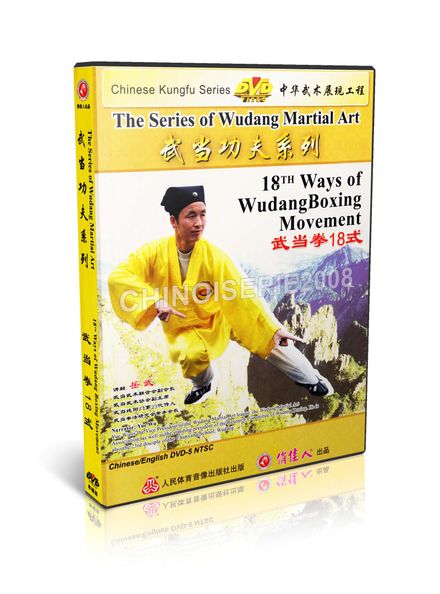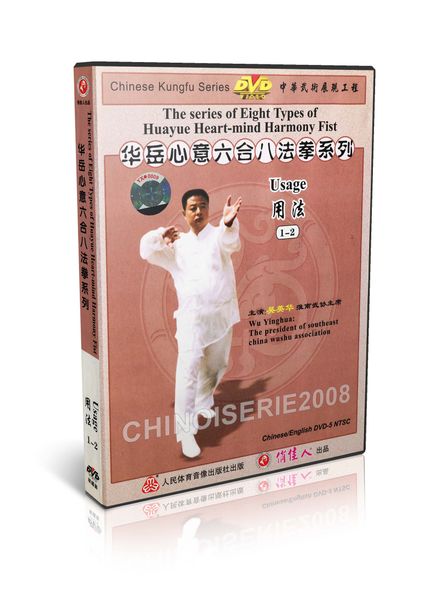$9.99
DW172 Chinese tradition Kungfu Tai Chi Qigong Selection Neigong Collection Edition DVD
Wang Wei is a member of Chinese Wushu Association and judge of Chinese Wushu Level 6 Test and Shanxi Wushu Level Test. He has won golden medals in national Wushu competitions for times and hailed Outstanding Inheritor of Zhaobao Taiji Quan of Wudang by Mount. Wudang Boxing Research Society, and One of Hundred Excellent Men of Chinese Wudang by Physical Education Bureau and Wushu Administrative Centre of Hubei.
This is a collection of demonstrations of Mr.Wang Wei, including Zhaobao Taiji Quan, dragon-shaped Taiji Qiu, horizontal and vertical piles of Neigong, methods of breathing and massage,Ba Duan Jin, etc. It is valuable for collection, research and appreciation.
- Lecturer: Wu Wei
- Format: ISO
- Language Speaking: Chinese
- Subtitle: Chinese
- Length of time: 48'41"
- Qigong Martial Arts After Bodhidharma
Qigong (a.k.a. chi kung) martial arts continued to develop outside of the Shaolin Monastery even after Bodhidharma’s death.
While Buddhist monks went on to develop the Shaolin Wugong for which they eventually became famous, Taoists and secular practitioners applied qigong (a.k.a. chi kung) to other forms of internal arts called neigong.
Internal alchemy, a form of nei dan qigong, that focused primarily on Taoist meditation, also flourished.
Manuals such as the Taixi Jinzhu (Commentary on Fetal Breathing) by Teacher Huan Zhen surfaced among the secular public.
This commentary introduced fetal breathing techniques that conserved the yuan chi (also phonetically spelled yuanqi, translated as primordial chi) and shen (spirit) for the purpose of attaining immortality.
Thus, qigong continued to develop unabated in the secular community outside monastic life. Neigong and health both saw practical qigong techniques being applied, as seen in the following examples of assorted well-known texts. I have categorized them according to the chronological dynastic periods in which they were written.
- Tang Dynasty (618-907 A.D.):
Huanzhen Xiansheng Funei Yuanqi Jue (Teacher Huanzhen’s Oral Transmission of Consuming Primordial Chi). This work discusses three areas of qigong: dietary and general suggestions, embryonic or fetal breathing and other breathing techniques that also include Liu Qi Jue (Six Therapeutic Breathing Techniques).
Zhu Bing Yuan Hou Lun (Thesis on the Origins and Symptoms of Diseases). Written by Chao Yuan-Fang, this collection lists 260 different techniques for stimulating vital chi circulation.
Qian Jin Fang (Thousand Gold Prescriptions) by Sun Si-Mo. Completed around 652 A.D., the text describes a method of guiding the chi and the therapeutic use of six sounds.
Wai Tai Mi Yao (Important Secrets From the External Pavilion). Published around 752 A.D., this text was written by Wang Tao and discusses the use of qigong and herbal therapies for disorders associated with chi circulation.
Cunshen Lian Qi Ming (Concentrating the Spirit and Refining the Breath) by Sun Simo. This manual focuses on three aspects of chi cultivation: general breathing techniques, five steps to merging with the Tao, and seven subsequent advance stages.
Huangting Dunjia Yuanshen Jing (Book of the Hidden Period and Causal Body of the Yellow Court). A manual that combines meditation with the Six Therapeutic Breaths and Taoist use of invocation and the writing and swallowing of a magic talisman.
I have heard of this practice still being continued today and with some very interesting results!
- Song Dynasty (960-1279):
Yang Sheng Jue (Nourishing Secrets) A culmination of work during Song, Jin, and Yuan Dynasties (960-1368) written by several different authors.
Bichuan Zhengyang Zhenren Lingbao Bifa (The Secret Legacy of Master Zhenyang’s Sacred Jewel) by Zhong Li-Quan or Yun Fang. The manual provides instructions on three stages: breath control and gymnastics, chi circulation and meditation, and transfiguration.
- Jin and Yuan Dynasties (1115-1368):
Ru Men Shi Qin (The Confucian Point of View) by Zhang Zi-He. Here, he prescribes qigong as a remedy for external injuries such as sprains and cuts.
Lan Shi Mi Cang (The Secret Library of the Orchid Room) by Li Dong-Yuan. This text prescribes qigong and herbal remedies for internal ailments.
Ge Zhi Yu Lun (A Further Thesis of Complete Study) by Zhu Dan-Xi. This document suggests using qigong in curing disease.
Zazhu Jie Jing (Various Shortcuts to the Tao). Here is a collection of exercises with anatomical descriptions and a guide to the Ba Duan Jin (Eight Pieces of Brocade) .
- Ming and Qing Dynasties (1368-1911):
Chen Xi-Yi Er-Shi-Si Qi Daoyin Tushi (Chen Xi-Yi’s Twenty-Four Daoyin Illustrations) by Chen Xi-Yi or Tu-Nan. The text shows twenty-four postures, corresponding to seasonal divisions, chi circulation in the meridians and through the viscera, the Five Elements and yin-yang characteristics.
Many texts written during the Ming and Ch’ing dynastic periods were largely commentaries of earlier works from the Han, Tang, Song and Yuan Dynasties. While many qigong techniques continued to flourish at this time, the principles and basic techniques underwent little change.
Also, many of qigong practices were described in either poetry with vague references or alchemical analogies, some of them deliberately, because they were secret legacies meant to be passed on directly from master to disciple. (See The Traditional Master-Disciple Relationship).
- Other Developments of Qigong Martial Arts
During the Song Dynasty between 960 and 1279, Taoist Zhang San-Feng developed another well-known form of neigong known as Tai Chi Chuan (also phonetically spelled Taijiquan)Martial Arts. Because this form was created on Wu Dang Mountain, this location has since become known as the center of Taoist internal arts.
In 1026, physician Wang Wei-Yi created the famous brass man of acupuncture, in addition to writing Tong Ren Yu Xue Zhenjiu Tu (Illustrations of the Brass Man Acupuncture and Moxibustion).
This manual describes the twelve organs and their relationship to twelve meridians. Versions of the brass man, complete with acupuncture holes or dots to indicate location of acupuncture points, are still used today.
For the first time, acupuncture theory was systematized, and it clarified how the chi energy circulated through the body through channels called meridians.
During the Southern Song Dynasty (1127-1279, the legendary Marshal Yue Fei was credited for creating several exercises and internal martial arts. Though some historians suggest that Ba Duan Shi (Eight Pieces of Brocade) Martial Arts resemble and could have originated with the Martial Arts classic Yi Jin Jing, most credit Yue Fei for its creation.
He is also credited for creating another popular internal martial art known as Hsing Yi (also phonetically written Xing Yi) Martial Arts, as well as Eagle Claw Martial Arts.
Thereafter, many other qigong forms were created, including Hu Bu Gong (Tiger Step Qigong), Shi-Er Zhuang (Twelve Postures), and Jiao Hua Gong (Beggar Qigong).
Wang Zu-Yuan wrote the Neigong Tu Shuo (Illustrated Explanation of Neigong) in which he described the Shi-Er Duan Shi (Twelve Pieces of Brocade) as a combination of both dynamic and stationary qigong.
Another style known as Huo Long Gong (Fire Dragon Qigong) surfaced during the late Ming Dynasty (circa 1640). During the late Ch’ing (or Qing) Dynasty Dong Hai-Chuan created the still famous Pa Kua Chang (also phonetically written Ba Gua Zhang, i.e. Eight Trigrams Palm) Martial Arts.
Also during the Ch’ing Dynasty (1644-1911) was the spread of Tibetan meditation and martial arts, spurred on by the interests of the Imperial Court and other high-ranking Mandarin officers.
Although qigong has been applied to both neigong (internal arts) and waigong (external arts), today, it is much more associated with the internal arts such as tai chi chuan and hsing yi that focus on building nei dan (internal elixir) or internal chi energy.
In contrast, Shaolin Temple is considered the authority on waigong or external arts, because it emphasizes exercises on wai dan (external elixir) or exercises whose purpose is to cultivate external chi energy.
That is not to say that qigong is any less relevant in Shaolin Wugong, but the focus is different:
Whereas, traditionally, waigong such as the Shaolin Martial Arts begins with training the wai dan chi (external energy), then gradually progresses to training with nei dan chi (internal energy), neigong such as Tai Chi Chuan Martial Arts focuses on training the nei dan chi, although training on wai dan chi is also included.
Ultimately, both types — Internal and External Martial Arts — receive focus on developing the vital chi energy in all aspects.



